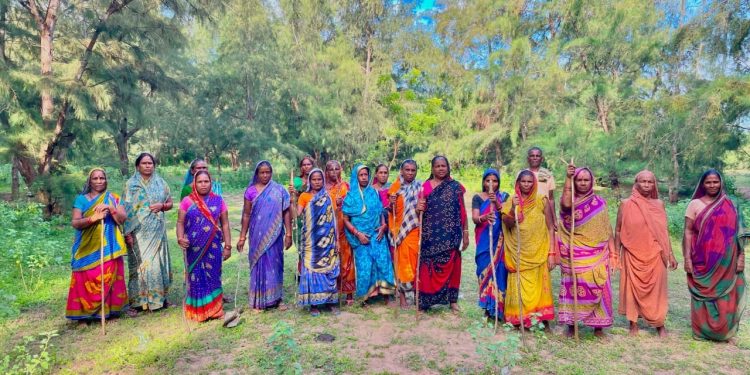Puri: In the remote coastal village of Sahan at the Devi river mouth in the district, a group of women fisherfolk has been quietly making history for the past 25 years. The ‘Maa Gangadevi Jungle Surakhya Committee’, led by these resilient women, has become a beacon of community-led forest protection. Members of the committee, along with their families, rely on trading fish, dry fish in particular, to sustain their livelihoods. However, despite their unprivileged background and limited formal education, they have shown unparallel commitment towards nature conservation.
Since 1999, in the aftermath of the devastating Super Cyclone, they have been protecting the casuarina and mangrove forests surrounding their village. This initiative is carried out through a routine group system known as ‘Thenga Pali’ where women, armed with wooden sticks, take turns patrolling the forests.
Each morning, the committee members venture into the forest carrying food and water for the day. Their mission is to guard the casuarina and mangrove stretches from any threats— from illegal logging or other harmful activities. They do not hesitate to confront those who pose a danger to the forests while working closely with local Forest department to ensure the necessary actions against the trespassers.
Also Read: Prolific writers of Odisha: From Kalindi Charan Panigrahi to Manoj Das
In addition to protecting the forest, they also lead beach cleanup drives at the Devi River mouth, Sagan Beach, and Jahania Beach—crucial breeding sites for the vulnerable Olive Ridley turtles. Though this community-driven initiative has not been officially recognised by any government policy, its impact is undeniable. The women of the committee have nurtured a legacy of forest protection spanning across generations. Abali Behera, a committee member, said, “We know the great value of our native forests and mangrove ecosystems. They protect us from the strong winds that come from the sea. We are committed to safeguarding them for our safety.” Another core member, Nabi Dei, highlights the vital role of mangroves in their lives. “Our homes and the river are separated only by a soil wall. The mangroves make that wall stronger. My family depends on fishing and collecting crabs, which thrive thanks to the mangroves’ presence. We protect them for our safety and the safety of future generations.” The committee has also been playing an active role in collaborating with local administration and various stakeholders in forest restoration and conservation initiatives.






































